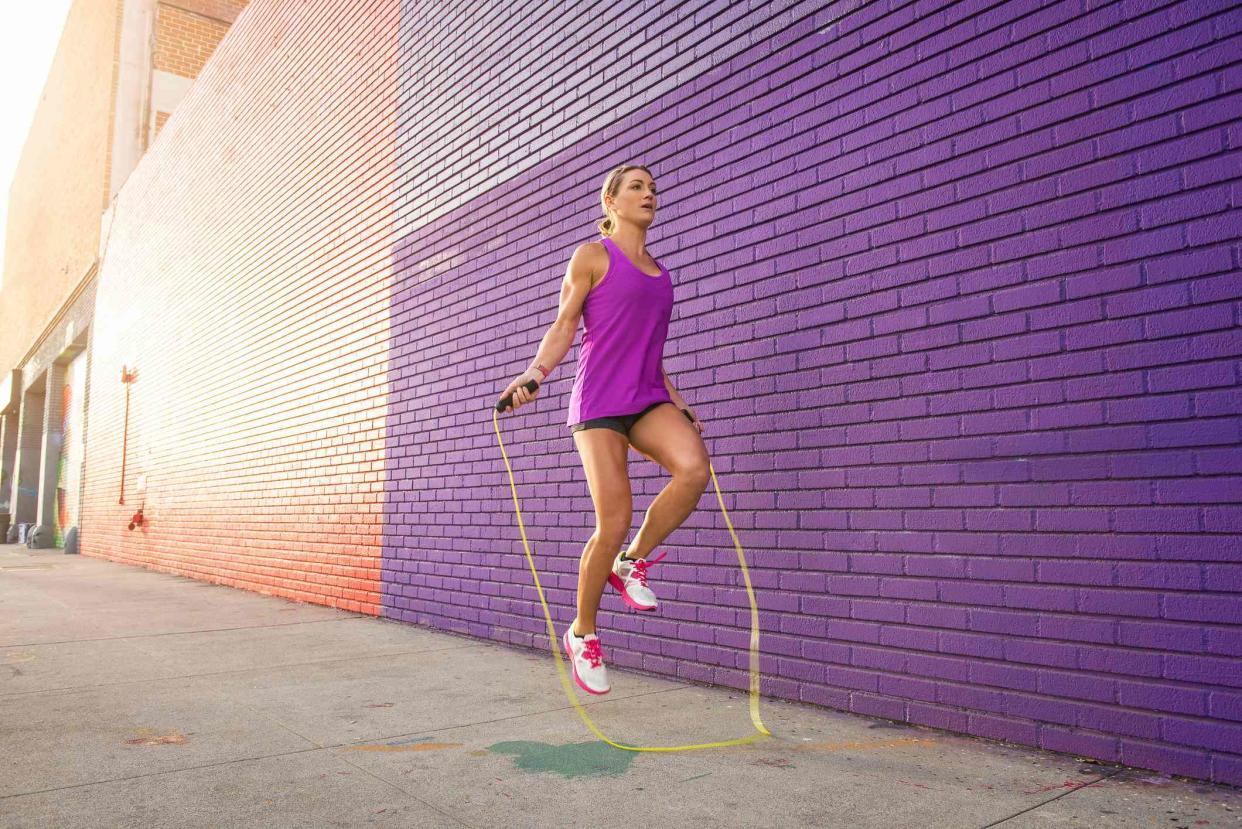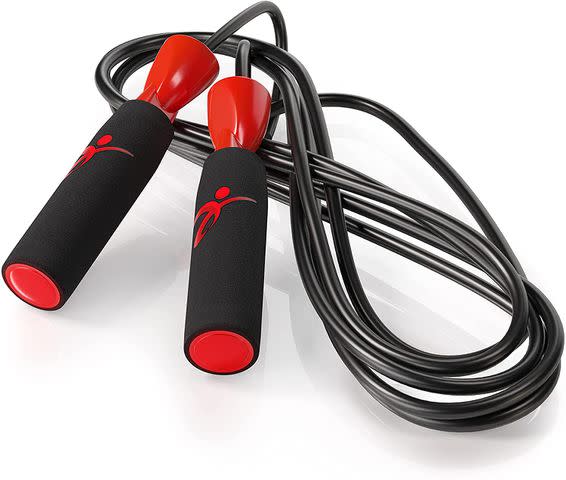Jump Rope Workouts for All Fitness Levels

Corey Jenkins / Getty Images
Medically reviewed by Kristin McGee, CPT
Jump rope workouts, once a staple of childhood playgrounds and boxing gyms, have made the leap into the general fitness world. The humble jump rope offers an impressive workout, combining high-intensity effort with core engagement to work up a sweat that also boosts cardiovascular health.
Ahead, you’ll learn the benefits of jump rope workouts, find guidance for beginners, and discover a variety of jump rope HIIT workouts suitable for all fitness levels. Whether you're wondering if jumping rope is a good workout for you or seeking new ways to challenge yourself, you can find what you need to know below.
Benefits of Jump Rope Workouts
Cardio exercise, such as jumping rope, is incredibly beneficial for your health. It helps to promote a healthy weight balance, improves sleep quality, expands lung capacity, boosts your sex life and bone density, and may help ease anxiety. It also may significantly lower the risk of major health risks such as heart attacks, high blood pressure, and diabetes. Plus, it can set a positive example for those around you.
Jump rope workouts provide an excellent cardio session. The high-intensity nature of the exercise gets your heart pumping, improving cardiovascular health and endurance. Jumping rope also enhances coordination and agility. The rhythmic motion of jumping rope requires timing and precision, skills that translate well into other sports and daily activities.
Beyond cardio and coordination, jump rope workouts offer a full-body workout. They engage your legs, core, arms, and shoulders, making them an excellent choice for an effective and efficient workout if you're short on time. One of the most appealing aspects of jump rope workouts is their accessibility and portability. A jump rope is lightweight, easy to carry, and can be used virtually anywhere, making it a perfect tool for fitting a quick workout into your busy day.
One overlooked aspect of this fitness tool is how motivating it can be. Jump rope workouts are fun and engaging, adding the challenge of mastering new skills and providing variety. This helps keep exercise fresh and exciting, promoting consistency and long-term commitment to fitness.
Related: 19 Effective Cardio Exercises for a Gym-Free Workout
Getting Started with Jump Rope
As with any new fitness technique or tool, it's wise to learn how to use it safely and effectively to maximize the benefits and minimize the risk of injury. Here's a comprehensive guide to getting started with jump rope workouts.
Choosing the Right Rope

Courtesy of Amazon
The first step in your jump rope journey is selecting the best rope for your fitness level, goals, and needs. There are a few types to consider:
Speed ropes are lightweight and designed for quick, high-intensity workouts. Wire cables allow for faster spinning, providing a more efficient cardio workout in less time. They're perfect for those looking to boost their speed and agility.
Weighted ropes are heavier and provide a more intense workout, engaging more muscle groups. A weighted jump rope is similar to a conventional rope, but it has weighted handles that give your arms more exercise while skipping and help turn up the intensity. They're a great choice for those aiming to build strength and endurance.
Beaded ropes have colorful plastic beads threaded around a cord, making them durable and creating a rhythmic pattern during jumping due to the beads' weight. They're ideal for beginners as they provide good control, help develop timing and rhythm, and are easy to adjust.
Cordless ropes are a great solution if you're crunched for space or prefer a tangle-free experience. They're perfect for indoor workouts or confined areas and offer even more portability and ease of use. Since they have no cord, they don't require as much coordination as traditional jump roping, so they are a more user-friendly alternative that mimics the feel of a conventional rope through weighted, slip-free handles.
The best rope for you depends on your fitness level and workout goals. Beginners might find beaded ropes easier to handle, while those seeking a challenging workout might opt for weighted ropes. Speed ropes are best suited for experienced jumpers aiming to enhance their speed and agility, and if you're lacking space or coordination, a cordless rope is a great alternative.
Choose a Safe Environment
Safety is paramount when it comes to jump rope workouts. Choose a flat, non-slippery surface to prevent falls and injuries, and wear grippy, flexible, and supportive footwear to protect your feet from the rope while supporting your joints and preventing slips and falls.
Make sure there's enough overhead and peripheral space to avoid hitting anything with your rope. Outdoor spaces like parks can be great, but if you're indoors, a spacious room with a high ceiling is ideal.
Warm-up and Cool-down
Warming up before and cooling down after your jump rope workout is essential to prepare your muscles, heart, lungs, and nervous system for the exercise and aid recovery afterward.
For your warm-up, start with some light cardio, like jogging in place, followed by dynamic movements that target your calves, quads, hamstrings, and shoulders. Try hip circles, gate openers, bodyweight squats, and arm circles, which will help prepare your core, pelvis, hips, and upper body for the work ahead.
After your workout, cool down with a slower, less intense activity like walking, followed by some light stretches. This helps to gradually lower your heart rate and stretch out the muscles you've been working while also helping your nervous system return to a relaxed state so you can recover and reduce stress more effectively.
Related: 14 Cool Down Stretches to Add to Your Workout Routine
Listen to Your Body
While it's normal to feel a certain level of discomfort when starting a new workout regimen, it's important to listen to your body and differentiate between good and bad pain. If you experience sharp, persistent pain, stop exercising and rest. Remember, it's okay to take breaks when needed.
Start slow and work your way up to longer and more intense workouts. If you are new to exercise, you should seek advice from your healthcare provider before starting jump rope workouts since they can be more intense than other forms of cardio, such as walking.
Basic Jump Rope Technique
Arm movements: Keep your elbows close to your body, and use your wrists and forearms to swing the rope, not your shoulders.
Posture: Stand tall with your chest up and shoulders back. Look straight ahead, not at your feet.
Footwork: Jump on the balls of your feet, not your heels. Keep your jumps low to reduce impact.
Jump Rope Workouts for All Levels

Stocksy / Bonninstudio
Jump rope workouts can be modified to suit your level by adjusting factors such as rest times, speed, and duration. Here are three workouts designed for beginners, intermediates, and advanced jumpers.
Beginner Workout
If you're new to jump rope workouts, start with the basics. This beginner workout focuses on mastering the fundamental technique and building endurance.
Warm-up: 5 minutes of light cardio (jogging in place, jumping jacks)
Jump rope: 30 seconds of basic jumps
Rest: 30 seconds
Repeat steps 2 and 3 for 10 rounds
Cool-down: 5 minutes of stretching
Remember, it's okay to miss a jump. The goal is to keep trying and improve your coordination and timing.
Intermediate Workout
Once you're comfortable with the basic jump, it's time to up the ante. This workout increases your cardio fitness and builds on your agility and footwork by introducing new jump styles and reducing rest time.
Warm-up: 5 minutes of light cardio and dynamic stretching
Jump rope: 30 seconds of basic jumps
Rest: 15 seconds
Jump rope: 30 seconds of alternate foot jumps (jumping from one foot to the other)
Rest: 15 seconds
Repeat steps 2-5 for 10 rounds
Cool-down: 5 minutes of stretching
Advanced Workout: High-Intensity Interval Training (HIIT) Routine
For those seeking a challenging workout, this advanced HIIT routine combines high-intensity jumps with strength training exercises, providing a full-body workout and boosting your cardio, strength, and endurance.
Warm-up: 5 minutes of light cardio and dynamic stretching
Jump rope: 1 minute of double unders (pass the rope under your feet twice during one jump)
Strength exercise: 30 seconds of push-ups
Rest: 30 seconds
Jump rope: 1 minute of high knee jumps (lifting your knees high with each jump)
Strength exercise: 30 seconds of squats
Rest: 30 seconds
Repeat steps 2-7 for 5 rounds
Cool-down: 5 minutes of stretching
Related: Running vs. Jumping Rope: Which Should I Choose?
Read the original article on Verywell Fitness.

